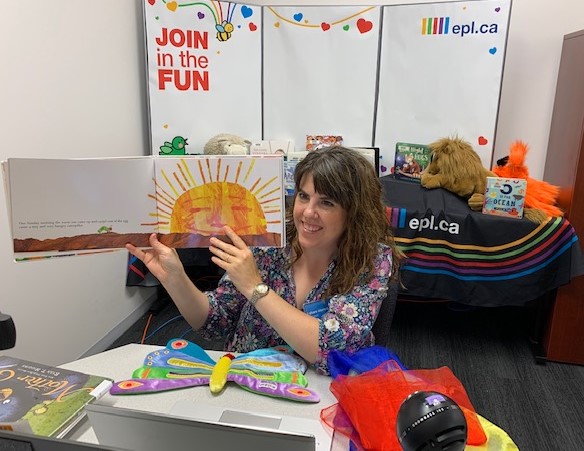Welcome to our fifth blog as part of our blog series on early literacy! Today, we'll talk about the importance of vocabulary development for young children's reading and learning.
Vocabulary is knowing and using words. Understanding and using a wide range of words is an important early literacy skill; children with strong vocabularies communicate more easily and recognize more words when they start to read.
Building a Strong Vocabulary
Here are some easy ways to help kids build a strong vocabulary:
Talk a lot: Have conversations with your child throughout the day. Ask questions and listen to their thoughts. Talking helps them learn new words and how to use them.
Read together: Reading aloud to kids is very helpful. It's an enjoyable way for kids to learn! Pick books with rhymes, books that use fun language and books that talk about things children see and do every day. Below is a booklist to get you started.
Describe things: Add descriptive words when you talk to your child. Instead of saying “look at the tree.” Say “look at the enormous oak tree! It has thick branches and bright green leaves!” It helps kids learn specific words.
Name and group things: Point to objects in your home and ask your child to name them. Organize things into groups, like fruits or animals, to help them understand and remember words.
Play word games: Games like "I Spy," "Rhyme Time" and "Guess the Word" are fun and teach new words and how they sound.
Explore your neighbourhood: Head outside and explore your surroundings. Parks, libraries and even the sidewalk have interesting things to see and talk about. A walk around the block can lead to learning new words!
Remember, learning new words takes time. Each child progresses at their own pace, so be patient and provide a supportive environment for learning. Celebrate your child's achievements and encourage their curiosity.
As you embark on this vocabulary-building journey, here's a list of books they'll enjoy:
-
Brown Bear, Brown Bear, What Do You See? by Bill Martin Jr. and Eric Carle
This classic picture book introduces children to various animals and colours through rhythmic text and vibrant illustrations. -
The Very Hungry Caterpillar by Eric Carle
Follow the journey of a caterpillar as it eats its way through different foods, teaching kids about numbers, days of the week and healthy eating. -
Chicka Chicka Boom Boom by Bill Martin Jr. and John Archambault
This lively alphabet book features catchy rhymes and vibrant illustrations, helping children entertainingly learn their ABCs. -
Goodnight Moon by Margaret Wise Brown
A classic bedtime story, this book takes children on a journey through a young bunny's room, naming various objects and creating a soothing bedtime atmosphere. -
Where's Spot? by Eric Hill
Join the search for Spot the puppy in this interactive lift-the-flap book, which introduces young readers to prepositions and animals. -
The Pigeon Needs a Bath! by Mo Willems
The humorous tale of a stubborn pigeon who refuses to take a bath, teaching children about hygiene and cleanliness. -
Dear Zoo by Rod Campbell
Lift the flaps to reveal different animals sent by the zoo, allowing children to learn animal names and characteristics. -
Go, Dog. Go! by P.D. Eastman
A fun-filled book featuring dogs engaging in various activities, teaching children about opposites, colours and prepositions. -
The Snowy Day by Ezra Jack Keats
Follow Peter on his snowy adventures as he explores his neighbourhood, discovering the joys of winter and expanding his vocabulary. -
Giraffes Can't Dance by Giles Andreae
This delightful story celebrates individuality and encourages self-confidence as Gerald the Giraffe learns that anyone can dance, no matter their differences. -
Brown Can Moo! Can You? by Dr. Seuss
With its lively rhymes and silly sounds, this book introduces children to onomatopoeia, allowing them to imitate various noises. -
The Gruffalo by Julia Donaldson
Follow a clever mouse as it encounters various creatures in the woods and outsmarts them, building vocabulary and critical thinking skills. -
Press Here by Hervé Tullet
An interactive book that encourages children to press, shake and tilt the pages, stimulating their imagination and introducing basic concepts like colours and numbers. -
Freight Train by Donald Crews
Learn about different colours and types of train cars as they travel across vibrant landscapes, engaging young readers in a colourful vocabulary adventure. -
The Very Busy Spider by Eric Carle
Watch a spider weave its web and encounter various farm animals, teaching children about animals, sounds and persistence.
Remember, every word counts! By helping your child learn more words and improve their vocabulary, you are setting them up for a successful future in reading and writing. Stay tuned for our next blog post, where we'll explore the connection between early literacy and play.
How to Play
I Spy: A familiar and always favourite game, especially for very young children, the game begins with someone saying “I spy with my little eye something that ____________________. The player can say “begins with the letter ______.” or “is the colour _______.” The other player(s) guess what the first player spied. Let your child guess, until they figure it out.
Rhyme Time: Pick a one-syllable word and have your child(ren) take a turn saying a rhyming word. For example, if you say the word “Pig” then your child may say “Wig”, then it will either be your turn again to say another word that rhymes or if there are multiple people someone else’s turn. Keep going until you cannot think of anymore rhyming words.
Guess the Word: All you have to do is think of a word and then describe it through clues and let your little one make a guess. The word could be an animal, food, job, or anything that you think your child could guess from clues.



Add a comment to: Beyond ABCs: Developing Vocabulary